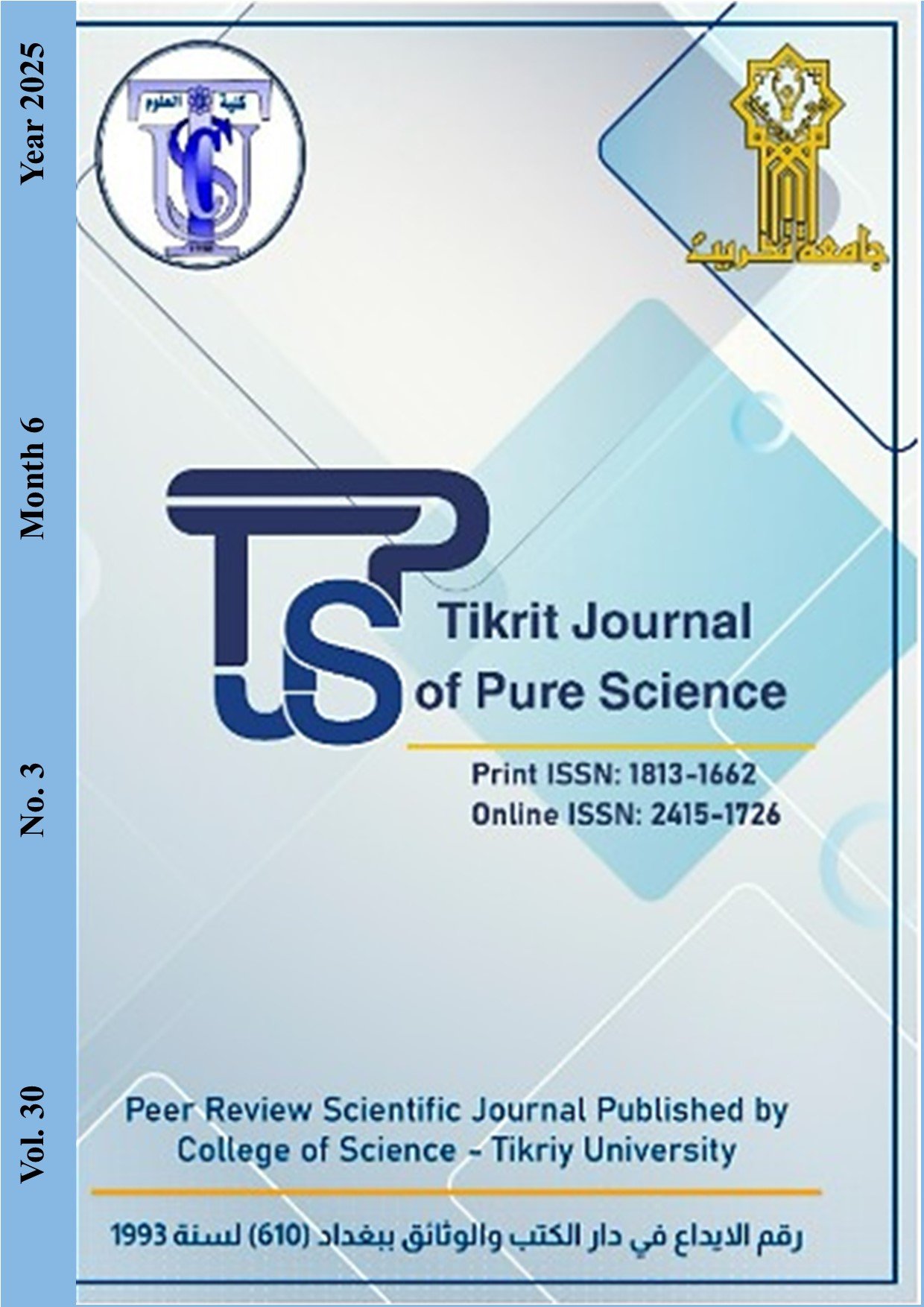Evaluation of the Bacterial Inhibitory Activity of Rhodotorula mucilaginosa on the Sensory Qualities of the Juice Compared with the Synthetic Dye
Main Article Content
Abstract
This study aimed to evaluate the inhibitory activity of the microbial dye extracted from the yeast Rhodotorula mucilaginosa, isolated from local oleander flowers. Beta-carotene dye was extracted and identified using high performance liquid chromatography (HPLC) technique. The results showed that the microbial dye exhibited inhibitory activity against Escherichia coli, Staphylococcus aureus, and Salmonella. A concentration of (0.1 g/ml) showed no inhibitory effect. At (0.2 g/ml), inhibition was observed only against Staphylococcus aureus with a diameter of (10.00 mm). Concentrations of (0.3, 0.4, and 0.5 g/ml) showed inhibition against all tested bacteria, with inhibition zones at (0.3 g/ml) being (5.00, 12.00, and 5.00 mm), at (0.4 g/ml) being (10.00, 15.00, and 8.00 mm), and at (0.5 g/ml) reaching the highest values of (12.00, 15.00, and 10.00 mm), respectively. Sensory evaluation of juice containing the microbial dye compared to synthetic dye showed a significant improvement in color (9.96 vs. 7.96, p < 0.05), with no significant differences in taste and flavor. A significant enhancement (p < 0.05) was noted in the texture (9.6 vs. 7.86) and overall acceptability (9.74 vs. 7.19) of the microbial dye. The findings demonstrate that the microbial dye not only possesses antimicrobial properties that help extend the shelf life of foods and beverages but is also well accepted by consumers. Additionally, it serves as a source of vitamin A and plays a valuable biological role in human health.
Article Details

This work is licensed under a Creative Commons Attribution 4.0 International License.
Tikrit Journal of Pure Science is licensed under the Creative Commons Attribution 4.0 International License, which allows users to copy, create extracts, abstracts, and new works from the article, alter and revise the article, and make commercial use of the article (including reuse and/or resale of the article by commercial entities), provided the user gives appropriate credit (with a link to the formal publication through the relevant DOI), provides a link to the license, indicates if changes were made, and the licensor is not represented as endorsing the use made of the work. The authors hold the copyright for their published work on the Tikrit J. Pure Sci. website, while Tikrit J. Pure Sci. is responsible for appreciate citation of their work, which is released under CC-BY-4.0, enabling the unrestricted use, distribution, and reproduction of an article in any medium, provided that the original work is properly cited.
References
1.Swapnil P, Meena M, Singh SK, Dhuldhaj UP, Marwal A. Vital roles of carotenoids in plants and humans to deteriorate stress with its structure, biosynthesis, metabolic engineering and functional aspects. Current Plant Biology. 2021;26:100203.https://doi.org/10.1016/j.cpb.2021.100203
2.Sultana S, Rahman MM, Aovi FI, Jahan FI, Hossain MS, Brishti SA, et al. Food color additives in hazardous consequences of human health: An overview. Current Topics in Medicinal Chemistry. 2023;23(14):1380-93.https://doi.org/10.2174/1568026623666230117122433
3. Nowacka M, Dadan M, Janowicz M, Wiktor A, Witrowa‐Rajchert D, Mandal R, et al. Effect of nonthermal treatments on selected natural food pigments and color changes in plant material. Comprehensive Reviews in Food Science and Food Safety. 2021;20(5):5097-144.
https://doi.org/10.1111/1541-4337.12824
4. Al-Naqeeb SAR. The effect of some plant extracts on the resistance Staphylococcus spp. Tikrit Journal of Pure Science. 2021;26(3):12-7.http://dx.doi.org/10.25130/tjps.26.2021.043
5. Hussein IMS. Determination of the minimum inhibitor concentration of Syzygium aromaticum extract on the growth of Pseudomonas aeruginosa isolated from burn infection. Tikrit Journal of Pure Science. 2021;26(3):7-11.
http://dx.doi.org/10.25130/tjps.26.2021.042
6. Park P, Cho D, Kim E, Chu K. Optimization of carotenoid production by Rhodotorula glutinis using statistical experimental design. World Journal of Microbiology and Biotechnology. 2005;21:429-34.https://doi.org/10.1007/s11274-004-1891-3
7.Pinu F, Yeasmin S, BARI ML, Rahman M. Microbiological conditions of frozen shrimp in different food market of Dhaka city. Food science and technology research. 2007;13(4):362-5.https://doi.org/10.3136/fstr.13.362
8.Younis A-RJ, Saleh MK. Determination of Inhibition Activity for Arak and Cloves Against Aerobic Bacterial Isolates from Patients of Dental Caries and Gingivitis. Tikrit Journal of Pure Science. 2020;25(5):15-21.http://dx.doi.org/10.25130/tjps.25.2020.083
9. Kovács Z, Sipos L, Szöllosi D, Kókai Z, Székely G, Fekete A. Electronic tongue and sensory evaluation for sensing apple juice taste attributes. Sensor Letters. 2011;9(4):1273-81.https://doi.org/10.1166/sl.2011.1687
10.سلمان وج. Nutritional and Evaluation properties of natural orange juice enriched by coconut milk as kids' nutritional drink. Journal of the College of Education for Women. 2018;29(4).
11.Alizadeh Behbahani B, Falah F, Lavi Arab F, Vasiee M, Tabatabaee Yazdi F. Chemical composition and antioxidant, antimicrobial, and antiproliferative activities of Cinnamomum zeylanicum bark essential oil. Evidence‐Based Complementary and Alternative Medicine. 2020;2020(1):5190603.https://doi.org/10.1155/2020/5190603
12.Kirti K, Amita S, Priti S, Mukesh Kumar A, Jyoti S. Colorful world of microbes: carotenoids and their applications. Advances in Biology. 2014;2014(1):837891.https://doi.org/10.1155/2014/837891
13. Kim M, Jung D-H, Seo D-H, Park Y-S, Seo M-J. 4, 4′-Diaponeurosporene from Lactobacillus plantarum subsp. plantarum KCCP11226: Low temperature stress-induced production enhancement and in vitro antioxidant activity. Journal of microbiology and biotechnology. 2021;31(1):63.https://doi.org/10.4014%2Fjmb.2010.10022
14.Koukouraki P, Tsoupras A, Sotiroudis G, Demopoulos CA, Sotiroudis TG. Antithrombotic properties of Spirulina extracts against platelet-activating factor and thrombin. Food Bioscience. 2020;37:100686.https://doi.org/10.1016/j.fbio.2020.100686
15.Neri-Numa IA, Arruda HS, Geraldi MV, Júnior MRM, Pastore GM. Natural prebiotic carbohydrates, carotenoids and flavonoids as ingredients in food systems. Current Opinion in Food Science. 2020;33:98-107.https://doi.org/10.1016/j.cofs.2020.03.004
